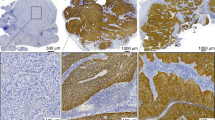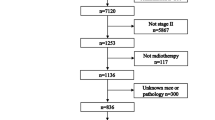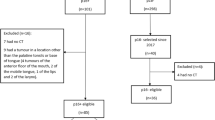Abstract
Design Retrospective cohort study.
Cohort selection OroGrams is a nomogram designed to better predict survival patterns in patients with oropharyngeal squamous cell carcinoma (OPSCC) by incorporation of both HPV-DNA and p16 status. The aim of this study was to evaluate the external validity of OroGrams in a Scottish population. The study population was noted to have a higher smoking status than the four European cohorts among which Orograms was originally developed and established.
Data analysis Retrospective analysis was undertaken of health records and death certificates of patients with OPSCC in Glasgow, Scotland between 2012 and 2017. Required baseline characteristics were compared to the original study cohorts to assess comparability. OroGrams was implemented to produce Kaplan Meier curves for overall and progression-free survival at one, three and five years. Brier scores were produced to compare these to the actual observed outcomes.
Results Compared to the UK study group, significantly more of the Scottish cohort presented at a later stage (p <0.001), were smokers (p = 0.002), and were both HPV-DNA and p16-negative. More patients received surgery or radiotherapy alone and less received a combination of both with chemotherapy. Low Brier scores indicated good predictive ability of OroGrams in the Scottish group at one, three and five years that was most accurate for overall survival. This accuracy was similar to the UK cohort at one and three years, but less so at five-year follow-up. Outcome predictions were significantly better for HPV-positive versus negative cases at all time points.
Conclusions OroGrams showed good prognostic accuracy for this Scottish cohort with significantly higher smoking, and HPV-DNA and p16-negative status, compared to the original UK study population. There were, however, limitations at longer follow-up periods and individual variation which limits its clinical application. Incorporation and weighting of smoking status and other comorbidities in future nomograms is recommended to enhance outcome understanding and better inform treatment planning.
This is a preview of subscription content, access via your institution
Access options
Subscribe to this journal
Receive 4 print issues and online access
$259.00 per year
only $64.75 per issue
Buy this article
- Purchase on Springer Link
- Instant access to full article PDF
Prices may be subject to local taxes which are calculated during checkout
Similar content being viewed by others
References
Kato M G, Baek C-H, Chaturvedi P et al. Update on oral and oropharyngeal cancer staging - International perspectives. World J Otorhinolaryngol Head Neck Surg 2020; 6: 66-75.
Lawrence M S, Sougnez C, Lichtenstein L et al. Comprehensive genomic characterization of head and neck squamous cell carcinomas. Nature 2015; 517: 576-582.
Balachandran V P, Gonen M, Smith J J, DeMatteo R P. Nomograms in oncology: more than meets the eye. Lancet Oncol 2015; DOI: 10.1016/S1470-2045(14)71116-7.
Grønhøj C, Jensen D H, Dehlendorff C et al. Development and external validation of nomograms in oropharyngeal cancer patients with known HPV-DNA status: a European Multicentre Study (OroGrams). Br J Cancer 2018; 118: 1672-1681.
von Elm E, Altman D G, Egger M, Pocock S J, Gøtzsche P C, Vandenbroucke J P. The Strengthening the Reporting of Observational Studies in Epidemiology (STROBE) statement: guidelines for reporting observational studies. Lancet 2007; 370: 1453-1457.
Bossi P, Miceli R, Granata R et al. Failure of Further Validation for Survival Nomograms in Oropharyngeal Cancer: Issues and Challenges. Int J Radiat Oncol Biol Phys 2018; 100: 1217-1221.
Birkeland A C, Uhlmann W R, Brenner J C, Shuman A G. Getting personal: Head and neck cancer management in the era of genomic medicine. Head Neck 2016; DOI: 10.1002/hed.24132.
Author information
Authors and Affiliations
Rights and permissions
About this article
Cite this article
Robbins, J., Ali, K. What is the predictive value of OroGrams to estimate survival rates of HPV-positive oropharyngeal squamous cell carcinoma?. Evid Based Dent 23, 14–15 (2022). https://doi.org/10.1038/s41432-022-0242-2
Received:
Accepted:
Published:
Issue Date:
DOI: https://doi.org/10.1038/s41432-022-0242-2



